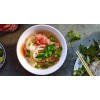How To Make Best Homemade Ramen
A wide variety of ramen exists in Japan, with geographical and vendor-specific differences even in varieties that share the same name. Ramen can be broadly categorized by its two main ingredients: noodles and broth.
Ramen is a Japanese dish. It consists of Chinese-style wheat noodles served in a meat or (occasionally) fish-based broth, often flavored with soy sauce or miso, and uses toppings such as sliced pork, dried seaweed, menma, and green onions. Nearly every region in Japan has its own variation of ramens, such as the tonkotsu (pork bone broth) ramen of Kyushu and the miso ramen of Hokkaido.
A wide variety of ramen exists in Japan, with geographical and vendor-specific differences even in varieties that share the same name. Ramen can be broadly categorized by its two main ingredients: noodles and broth.
- Noodles
Most noodles are made from four basic ingredients: wheat flour, salt, water, and kansui a type of alkaline mineral water, containing sodium carbonate and usually potassium carbonate, as well as sometimes a small amount of phosphoric acid.
The kansui is the distinguishing ingredient in ramen noodles, and originated in Inner Mongolia, where some lakes contained large amounts of these minerals and whose water is said to be perfect for making these noodles. Making noodles with kansui lends them a yellowish hue as well as a firm texture. Eggs may also be substituted for kansui. Some noodles are made with neither eggs nor kansui and should only be used for yakisoba, as they have a weaker structure and are more prone to soaking up moisture and becoming extremely soft when served in soup.
Ramen comes in various shapes and lengths. It may be thick, thin, or even ribbon-like, as well as straight or wrinkled.
- Soup
Ramen soup is generally made from stock based on chicken or pork, combined with a variety of ingredients such as kombu, katsuobushi, niboshi, beef bones, pork bones, shiitake, and onions. Some modern Ramen broths can also be vegetable based.
Tonkotsu soup usually has a cloudy white colored broth. It is similar to the Chinese baitang and has a thick broth made from boiling pork bones, fat, and collagen over high heat for many hours, which suffuses the broth with a hearty pork flavor and creamy consistency that rivals milk, melted butter or gravy.
How to make Ramen/ Ramen recipe/homemade ramen
Serves: 4 to 6
Ingredients
For the broth:
- 6 to 6 1/2 pounds chicken wings
- 4 medium carrots (about 8 ounces), cut into 1/2-inch-thick rounds
- 3 small bunches scallions (12 to 18), roots trimmed
- 10 cups water, divided
- 1 head garlic, skin on, roots removed, cut in half horizontally
- 1 (2-inch) piece ginger, peeled and cut into 1/4-inch pieces
- 20 dried shiitake mushrooms (about 2 ounces)
- 1 (6-inch) sheet dried kombu (sea vegetable or seaweed)
- 1/4 cup soy sauce
For the shoyu tare:
- 1/4 cup soy sauce
- 2 tablespoons mirin
For the eggs and noodles:
- 3 to 4 large eggs, depending on the number of diners
- 6 (5-ounce) packages fresh, thin, and wavy ramen noodles
For serving:
- 1/2 cup menma (fermented bamboo shoots)
- 6 medium scallions, thinly sliced
- 3 toasted nori sheets, cut into ribbons
- Chili oil or toasted (Asian) sesame oil
Equipment
Measuring cups and spoons
Chef's knife
Stovetop-safe roasting pan or large stovetop-safe casserole dish
Stockpot
Large saucepan
Strainer or slotted spoon (for skimming)
Fine-mesh strainer
Large bowl
Instructions
Make the broth and tare:
Roast the chicken wings. Arrange a rack in the middle of the oven and heat to 425°F. Place the chicken wings in a stovetop-safe roasting pan or casserole dish and roast until well-browned, about 30 minutes. Reduce the heat to 375°F, add the carrots and scallions, and stir to combine. Roast for 20 minutes more.
Deglaze the roasting pan. Transfer the chicken and vegetables to a stockpot. Place the now-empty roasting pan on the stovetop over high heat. Add 2 cups of the water and, stirring and scraping vigorously with a heatproof or metal spoon, scrape up all the flavorful browned bits from the bottom of the pan. Bring to a boil, then carefully pour the mixture into the stockpot.
Amp up the aromatics. Add the garlic, ginger, shiitakes, kombu, and remaining 8 cups of water to the pot and stir to combine. Bring just to a simmer over high heat — just a few bubbles around the edges.
Simmer the broth. Reduce the heat as low as your stove will allow, add the soy sauce, and simmer uncovered, occasionally skimming the fat and scum that accumulates on the surface, until the chicken has fallen completely off the bone and the wing bones come apart easily 3 to 3 1/2 hours.
Strain the broth. Pour the broth through a fine-mesh strainer into a large bowl; discard the solids. Cool the broth to room temperature, then cover and refrigerate overnight. Before using, skim the fat off the surface and discard.
Make the tare. Combine the soy sauce and mirin in a small airtight container, seal, and refrigerate until ready to use.
For serving:
Cook the eggs. Fill a large saucepan with a few inches of water and place over high heat until it comes to a rolling boil. Reduce the heat so that the water is at a rapid simmer. Gently lower the eggs into the water 1 at a time, then simmer for 6 minutes. Remove the eggs with a slotted spoon to an ice water bath. Peel the cooled eggs, cut in half lengthwise, and set aside.
Cook the noodles. Return the egg cooking water to a boil, add the noodles, and cook according to package directions, 3 to 5 minutes. Drain the noodles and run under cool water to stop the cooking.
Simmer and flavor the broth. Bring the broth back to a boil in a separate saucepan. Remove from the heat and add the tare to taste.
Assemble the bowls. Divide the noodles between 4 deep, wide bowls (or more bowls if you want to have smaller servings). Ladle on the hot broth. Top each bowl with 1 to 2 egg halves, bamboo shoots, scallions, and nori and drizzle with oil.
Reference:
https://www.thekitchn.com/how-to-make-the-best-ramen-at-home-236345
Related Articles
Search
Categories
Popular Posts






















Comments: 0
No comments